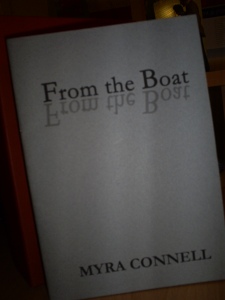‘From the Boat’ by Myra Connell
–Reviewed by Richard T. Watson–
There’s something dreamlike about Myra Connell’s pamphlet, From the Boat, published by Nine Arches Press. Look at it, all grey and unassuming:

That’s not what makes it dreamlike (unless you have dreams that are grey and unassuming). There’s a little joke in the way the title is reflected, as though the letters were a boat on water… see what they did there? The cover is grey, slightly textured, and wholly appropriate for the contents of From the Boat.
What’s dreamlike about Connell’s pamphlet is actually that, by the end of From the Boat, the reader has flitted through a range of memories and thoughts but can’t quite piece them together coherently. It’s as though half the links have been lost during the night, leaving the reader to try stringing together a jumble of episodes.
Connell opens From the Boat with an image of a boat drifting, itself an important theme, and waiting for the dawn. It’s night time, with a person waiting, and while waiting there is some soul-searching to be done. She closes From the Boat by returning to that drifting boat, two days (and forty pages) later, by which time both she and her reader have some thoughts and half-remembered dreams to mull over – as the boat drifts into the night.
So everything between those two moments on the boat comes, er, from the soul-searching on the boat. It becomes easy to see Connell’s first-person speaker (who begins ‘waiting for the water’ and ends ‘adrift again’) as searching through her memories. She’s on a quest, traipsing through quiet moments of loss and re-treading old woodland walks (see ‘The Quarry’ or ‘Old Map’).
Connell’s poems describe a world in which something is missing, often it feels like that something has been taken. The lines are stripped back to their basics, no messing about, this is language close to its simplest. That’s not to say the poems are without a sudden power. For example, ‘Note’ throws a curveball when it springs upon the reader the following questions:
‘Are the children screaming more today?
Or is it that the wind
the door-swing wind
is carrying their screams?’
Children screaming in the distance (from school playgrounds, I assume, rather than anything sinister) is a sound you only usually notice when alone. Like those questions, it’s the sort of thing that creeps up and catches you off-guard. Several poems in From the Boat are good at doing that. The faintly illogical ‘Peninsula’ alarmingly draws attention to the reader’s exposed neck, making it seem unnervingly vulnerable.
Admittedly not as vulnerable as necks appear to be at other times in From the Boat: ‘The Beheading of St John the Baptist’ is an obvious example. It’s one of several Connell poems based on a piece of visual art to which she has added dramatic voice. In this case she’s interested in things hidden by the painting (by Puvis de Chavannes, since you ask), again searching for something and ‘afraid of finding nothing’.
Unfortunately, finding nothing is a constant fear in From the Boat. Frequently, a poem is almost saying something, but slinking off and falling short before it manages to do so (see ‘Journey’ especially). The pamphlet’s blurb describes Connell’s work as ‘the opposite of heroic’, and that’s not wrong; the word they’re looking for is ‘bathos’.
That feeling of searching alone and of isolation that appeared in ‘Note’ crops up throughout From the Boat, especially in moments of people-watching like ‘Prayer’. Here the sounds of the city filter into a poem ostensibly about a woman and her salad, while barristas are ‘holding party court and flirting’. It may be at its strongest in ‘Dad’s Portrait’, where the portrait offers no company at all. Most importantly, this brief descriptive poem offers the biggest clue to the void at the centre of Connell’s poems: ‘he died cold blue’.
That statement comes as another startling twist to a poem, but sheds light on the minor strain of grief running through From the Boat. This opens up some meaning to the soul-searching in the night, as Connell’s ‘I’ comes to terms with her loss. Not that she’s any closer to closure by the end. In some ways, she seems to feel guilt herself; ‘How to treat someone who’s in shock’ throws out ‘She’s killed her father once again’ almost glibly, but the statement feels weightier than that.
Connell comes closest to articulating that sense of loss in ‘Earlswood Garden Centre Café’, a poem combining the isolation of earlier poems with the howling void occasioned by a parent’s death. It’s when she describes a ‘raw place in the gut’, the split ‘houses of a heart’ and being unable to ‘find South’ that she really nails it.
Mixing in with the loss and grief is a certain raw erotic charm to Connell’s From the Boat. Starting with early references to ‘our bodies skin to skin./ I loved a stranger in a sycamore wood’ she moves onto brutally visual descriptions of female forms – women who are fiercely provocative. Again, Connell is putting dramatic voice to visual art, in this case the unflattering drawings of Egon Schiele. Here’s one of the pictures Connell uses in ‘Egon Schiele (II): Squatting Woman With Boots (undated)’.
In this poem Connell’s writing is at its most vivid and edgy, with a playful yet confrontational sexuality. It’s a perfect companion to the expression Schiele’s drawing captures.
Schiele’s image is like Connell’s better poems – sharp, slightly painful and suddenly personal. But in general the front cover is a more suitable graphic representation of From the Boat – grey, bleak and downbeat.



